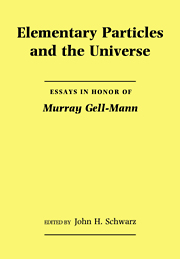Book contents
- Frontmatter
- Contents
- Preface
- Excess Baggage
- Through the Clouds
- Covariant Formulations of the Superparticle and the Superstring
- Chiral Symmetry and Confinement
- The Original Fifth Interaction
- The Mass Hierarchy of Leptons and Quarks as a New Symmetry
- Spacetime Duality in String Theory
- Supersymmetry and Quasi-Supersymmetry
- The Exceptional Superspace and the Quadratic Jordan Formulation of Quantum Mechanics
- Algebra of Reparametrization-Invariant and Normal Ordered Operators in Open String Field Theory
- Superconductivity of an Ideal Charged Boson System
- Some Remarks on the Symmetry Approach to Nuclear Rotational Motion
- Uncomputability, Intractability and the Efficiency of Heat Engines
- The New Mathematical Physics
- “Is Quantum Mechanics for the Birds?”
- The Gell-Mann Age of Particle Physics
- Remarks on the occasion of Murray Gell-Mann's more or less 60th Birthday
Supersymmetry and Quasi-Supersymmetry
Published online by Cambridge University Press: 11 November 2009
- Frontmatter
- Contents
- Preface
- Excess Baggage
- Through the Clouds
- Covariant Formulations of the Superparticle and the Superstring
- Chiral Symmetry and Confinement
- The Original Fifth Interaction
- The Mass Hierarchy of Leptons and Quarks as a New Symmetry
- Spacetime Duality in String Theory
- Supersymmetry and Quasi-Supersymmetry
- The Exceptional Superspace and the Quadratic Jordan Formulation of Quantum Mechanics
- Algebra of Reparametrization-Invariant and Normal Ordered Operators in Open String Field Theory
- Superconductivity of an Ideal Charged Boson System
- Some Remarks on the Symmetry Approach to Nuclear Rotational Motion
- Uncomputability, Intractability and the Efficiency of Heat Engines
- The New Mathematical Physics
- “Is Quantum Mechanics for the Birds?”
- The Gell-Mann Age of Particle Physics
- Remarks on the occasion of Murray Gell-Mann's more or less 60th Birthday
Summary
I first met Murray Gell-Mann when he popped up in my office at the Institute for Advanced Study, and described to me the isospin-strangeness rule he had discovered. He pronounced my name correctly and interpreted its meaning correctly. That was September 1953.
The post-War decades have been the Golden Age of particle physics. Theory and experiment went hand in hand to make amazing advances. What we know now about the world of elementary particles is incredibly richer than what we did forty years ago, and we owe this to Murray above all. Looking beyond the Baroque period we are in now, I hope Murray's spirit will come back alive again.
Recently I have been taking a renewed interest in the BCS mechanism as a model for spontaneous generation of fermion mass and associated Goldstone (G) and Higgs (H) collective bosons. Here I mean by a BCS mechanism the formation of fermion pair condensates due to a short range attraction. In an idealized situation, this may be represented by a four-fermion interaction, and the dynamics is essentially determined by the properties of fermion bubble diagrams. A characteristic feature of the bubble approximation is that the Bogoliubov–Valatin (BV) fermion and the Higgs boson have the simple mass ratio 1:2. Such modes are known to exist in superconductors.
These low energy modes can be represented by an effective Ginzburg–Landau– Gell-Mann-Lévy Hamiltonian in which the boson self-coupling and the boson-fermion Yukawa coupling are related so as to satisfy the mass ratios.
- Type
- Chapter
- Information
- Elementary Particles and the UniverseEssays in Honor of Murray Gell-Mann, pp. 89 - 98Publisher: Cambridge University PressPrint publication year: 1991
- 1
- Cited by

